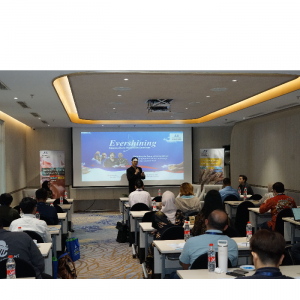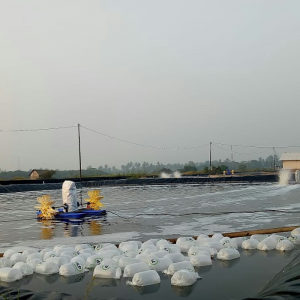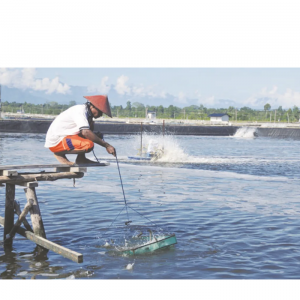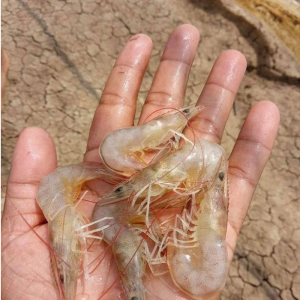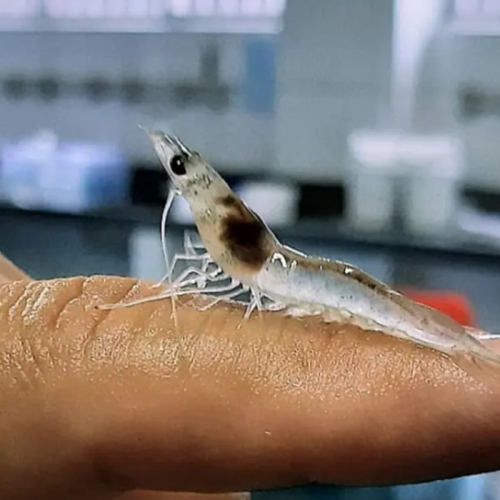
Synbiotic Technology in Rearing White-leg Shrimp in Seawater and Low-salinity Water
| Wed, 26 Jan 2022 - 14:00
In the current intensive shrimp farming models, minimizing water exchange in ponds is becoming the mainstream. To do that, it is necessary to maintain stable environmental criteria or water quality in ponds.
Typically, Biofloc technology, with the addition of organic carbon (such as sugar, molasses, plant bran) is added to the water to contribute to stimulating the growth of beneficial microorganisms. The heterotrophs and nitrifying bacteria help convert nitrogenous compounds into proteins in biomass as a natural food for fish and shrimp, besides helping to improve the aquatic environment.
Along with that trend, in a recent study by Professor Luis Otavio Brito da Silva and his colleagues, some new improvements were made in the application of synbiotics technology to whiteleg shrimp rearing in seawater and water with high temperature. low salinity, which improves growth rate and better water quality.
Synbiotic technology is the result of anaerobic or aerobic metabolism carried out by beneficial microorganisms (also known as probiotics), which is carried out on the plant substrate, animal, bran or other carbohydrate sources (soluble fibers are food sources for beneficial bacteria called prebiotics).
Read more: Controlling Pathogenic Bacteria in Shrimp with Probiotics
Substrate can be understood as a type of material on which microorganisms can grow (soil or substrate can be considered as a substrate). Beneficial microorganisms (probiotics) will promote the breakdown of complex organic molecules into simpler molecules, thereby helping to improve the environment in the pond.
The study was carried out for 42 days and consisted of 3 treatments. In the first two treatments at high salinity, water was introduced into the tank with a salinity of about 35ppt, and 13 mg/L chlorine was used for disinfection. Then, continuously aerate for 72 hours to dechlorinate. Next, add a mixture including: Urea fertilizer (4.5g N/m 3 ); Triple Superphosphate (0.3g P/m 3 ); and Sodium silicate (0.23g Si/m 3 ). In the low salinity treatment, seawater was diluted to a salinity of 0.2ppt, chlorination was performed similarly to the two treatments above, and fertilization was performed similarly.
Post larvae (PL10-24) were reared at a density of 2,000 to 3,000 shrimp/m3 in a nursery tank with a volume of 60L. Post shrimp will be fed 4 times a day with industrial feed (containing 45% protein and 9.5% lipids). Feeding frequency was adjusted weekly based on shrimp growth rate, feed intake and mortality. Environmental indicators are measured weekly and are always maintained at a suitable level for shrimp to grow well.
In the first treatment, the nursery tank continued to be fertilized every 3 days during the 42 days of the experiment. Before applying, the fertilizer used will be incubated in anaerobic conditions for 48 hours and under aerobic conditions for 24 hours. The composition of manure used includes wheat bran (from 22.5 to 50 g/m3), molasses (from 12 to 25 g/m 3) and sodium bicarbonate (from 4.5 to 10 g/m3). In addition, the probiotics Kayros Ambiental and Agrícola were added (this preparation includes Bacillus subtilis, B. licheniformis, Lactobacillus sp., Saccharomyces sp. and Pseudomonas sp.) with a concentration of 0.5g/m3.
Read more: Effects Of Carbohydrate Sources on A Biofloc Shrimp Nursery
In the second treatment, the nursery tank was also fertilized every 3 days within 42 days of the experiment. Fertilizers before being applied to the tank will be incubated in anaerobic conditions for 24 hours and continue to incubate in aerobic conditions for another 24 hours. The composition of manure used includes rice bran (20g/m3), molasses (2g/m3), sodium bicarbonate (4 g/m3). And finally (0.5g/m3) microbial products Kayros Ambiental and Agrícola.
In the 3rd treatment, Manure was also composted similar to the second treatment, fertilizer was applied to the nursery tank every 3 days for 40 days. The composition of manure introduced into the rearing tank was similar to that of the second treatment. In addition, in order to enhance the growth of microorganisms in the nursery tank, shells of bivalve crustaceans are added to create an artificial substrate for good growth of microorganisms, the number of shells accounts for about 28. % of bottom area of nursery tank (25 x 24 x 5 cm). Besides, the water of the nursery tank will be reused 15%.
Research results after 42 days show that the water quality of the nursery tanks is always stable, with dissolved oxygen concentration of 5.0 mg/L; TAN is 0.33 to 0.6 mg/L; NO 2 -N is 1.56 mg/L; and alkalinity above 95 mg CaCO 3 /L. Post larvae in all 3 treatments developed well with a survival rate of up to 84%, the weight of shrimp at the end of the treatment was from 0.85 to 0.98 grams, and the FCR was in the range of 1.2 to 1, 34 while the output increased from 1.53 to 2.50 Kg/m 3 .
Based on the results of this study, the combined use of plant bran (anaerobic and aerobically digested) as an organic carbon source, with probiotics, artificial substrates (shells) is demonstrated. scallops) and reuse of water in the rearing tank has great potential to significantly control nitrogen compounds (TAN and NO 2 -N) and have a positive effect on the growth of white leg shrimp in nursery tanks with seawater and low salinity water in a synbiotic model.
Source: tepbac.com













